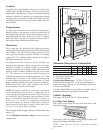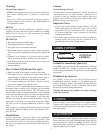
Mobile Home Installation
The installation of this range must conform to the
Manufactured Home Construction and Safety Standards,
Title 24 CFR. Part 3280 (formerly the Federal Standard
for Mobile Home Construction and Safety, Title 24, HUD,
Part 280); or when such standard is not applicable, the
Standard for Manufactured Homes Installations 1982
(Manufactured Home Sites, Communities and Setups),
ANSI A225.1q/NFPA 501A* or with local codes.
The installation of this range must conform with the
current standards CAN/CSA-Z240–latest edition*** or
with local codes. When this range is installed in a mobile
home, it must be secured to the floor during transit. Any
method of securing the range is adequate as long as it
conforms to the standards listed above.
Note: The metal chassis of the range MUST be earth-
grounded in order for the control panel and burner spark
ignition to work. Check with a qualified electrician if you
are in doubt as to whether the metal chassis of range is
earth-grounded.
Copies of the standards listed may be obtained from:
* National Fire Protection Association
Batterymarch Park
Quincy, Massachusetts 02269
** American Gas Association
1515 Wilson Boulevard
Arlington, Virginia 22209
*** Canadian Standard Association
178 Rexdale Boulevard
Rexdale (Toronto), Ontario M9W 1R3
Floor Covering
Never install a range over inferior kitchen carpeting, vinyl
tile or linoleum. These should be able to withstand at least
175°F without shrinking, warping or discoloring.
Curtains
If your range is near a window, use an appropriate window
treatment. Do not use long curtains which could blow over
the top burners and create a fire hazard.
If You Smell Gas
If this is a new range installation, your installer has not
done a proper job of checking for leaks. Connections can
loosen in transportation. If the range connections are not
perfectly tight, you can have a small leak and therefore a
faint gas smell.
FINDING A GAS LEAK IS USUALLY NOT A
“DO IT YOURSELF” PROCEDURE.
Some leaks can only be found with the controls in the
“on” position exposing the user to serious burns. Never
use a match or flame to locate a leak. Turn off the gas to
the range and call a qualified serviceman.
Flame Size: Top burner flame size should be adjusted so
it does not extend beyond the edge of the cooking utensil.
Excessive flame is hazardous.
Use of High Flame: When using a high flame, never
leave any pans unattended on this heat setting for long
periods. Hot oil is particularly hazardous since it can
become hot enough to ignite.
Do not obstruct the flow of combustion and ventilation air
to the range.
Any openings in the wall, behind the range or the floor
under the range must be sealed.
Venting
Never block the vents (air openings of the range). They
provide the air inlet and outlet which is necessary for the
range to operate properly with correct combustion. The
oven vent is located at the rear of the main top.
Type of Gas
Natural and LP Gas (propane). Ranges are factory
assembled for natural gas unless otherwise specified and
cannot be used with LP Gas without some adjustments.
Be sure your range is correctly adjusted by a qualified
serviceman or installer for the type of gas on which it is to
be used. (See Conversion, page 12).
NOTE: In this manual, propane is referred to as LP
(liquid petroleum).
Gas hook up locations - Model 1955: The 1/2” steel gas
elbow exits the stove on the right side, 34” off the floor.
On Model 1956, the connection is located in the center,
2” off the floor.
INSTALLING YOUR RANGE
Be sure your appliance is properly installed and grounded
by a qualified technician in accordance with the installation
instructions and local building codes.
Power cord installation
The new U.S. revised electrical code states that all new
construction must use a FOUR WIRE range power cord.
Existing construction may use a three wire range power
cord. NOTE: The difference is, a four wire cord has a
separate ground. A three wire cord is grounded through
the neutral.
Installation, adjustment and service of this range must
be performed only by a qualified gas range installer or
electrical serviceman. This is necessary to insure proper
operation of the range and to avoid the possibility of
damage to the range or injury to the users.
WARNING: Be careful when reaching into storage cabinets
above range while it is in operation. One might accidentally
contact a hot burner when using a hand for support or have
one’s clothing come in contact with top burner flame.
5


















